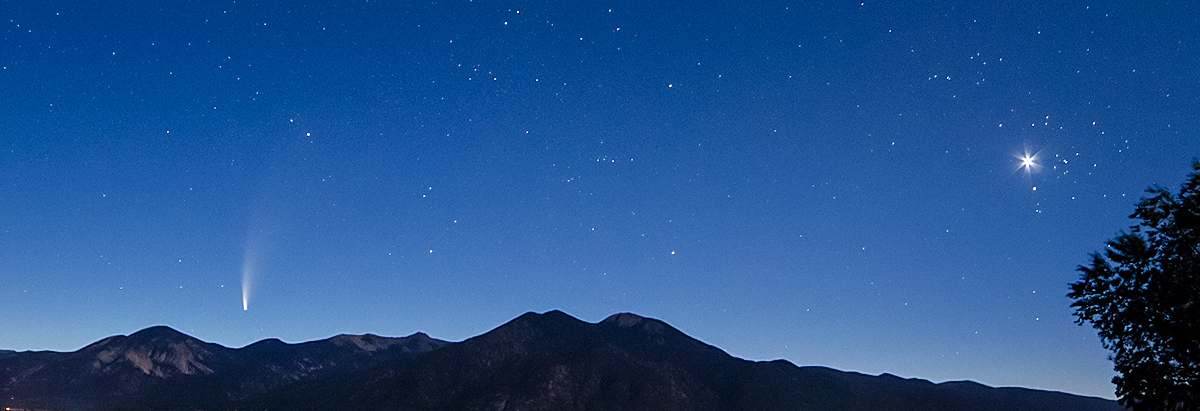
Welcome to taosastronomer.com!
offering
local "hands-on" observing
(visual and imaging) sessions and instruction
viewing and imaging from Rabbit Valley Observatory
a dark sky location on the mesa just west of Taos, NM
Image obtained October 20-21, 2016 through RVO's Megrez 80mm refractor with Orion field-flattener lens, using a Baader-modified Canon XSi DSLR and BackyardEOS image-acquisition software – 23 carefully selected and stacked 120-second luminance frames combined with multiple dark, flat and bias calibration frames shot at ISO 1600 and totaling more than 126 minutes (~46 minutes effective luminance) were used to create this image; optics driven by the Losmandy G-11 mount equipped with Ovision's precision RA worm gear, guided with a ZWO ASI 120MM Monochrome CCD camera through a 60mm guidescope using PhD2 guiding software and post-processed with DeepSkyStacker and Photoshop CS3 s/w.
“Galactic open clusters occupy a wide range of ages, sizes, initial mass functions, and metallicities, and they are found throughout the Galactic disk. Thus, open clusters are excellent tracers of Galactic disk properties and give insight into the formation of the disk. Unfortunately, the fundamental properties of open clusters are difficult to determine. Current estimates of these properties vary widely; there is only marginal agreement in the literature about the age, metallicity, reddening, or galactocentric distance of any given open cluster. Part of the disparity between estimates is due to the variety of methods used to determine these quantities. The published metallicity estimates of an open cluster are especially prone to disagreement because each technique has different sensitivities to metallicity patterns, and it is likely that none of the methods commonly used to estimate stellar metallicity, with the possible exception of high-resolution spectroscopy, is measuring the “true” metallicity of the stars. Additionally, the relationship between the many different techniques is often unknown. The past few decades have yielded significant advances in the study of open clusters, but there is still much work to be done toward determining the fundamental properties of the more than 1500 currently known Galactic open clusters. Nonetheless, open clusters are extremely useful objects to study, because each cluster represents a homogeneous set of stars. All stars in an open cluster form at the same time and in the same circumstances and thus are expected to have the same age, metallicity, and galactocentric distance. For this reason, open clusters are good test beds for many types of Galactic studies. For example, they may be ideal objects in which to search for extrasolar planets. Furthermore, open clusters can be metal-rich objects. Metal-rich environments have recently received attention due to the suggestion that extrasolar planets form more readily around metal-rich stars. If this is the case, metal-rich open clusters may be excellent places to search for extrasolar planets.” -- from J.L. Marshall, an astronomer from the University of Ohio, as he described the cluster in the 2005 study “Survey for Transiting Extrasolar Planets in Stellar Systems. II. Spectrophotometry and Metallicities of Open Clusters“
[copyright Rabbit Valley Observatory/Willis Greiner, 2016 -- all rights reserved]
|
Image (merely enlarged from image above) obtained October 20-21, 2016 through RVO's Megrez 80mm refractor with Orion field-flattener lens, using a Baader-modified Canon XSi DSLR and BackyardEOS image-acquisition software – 23 carefully selected and stacked 120-second luminance frames combined with multiple dark, flat and bias calibration frames shot at ISO 1600 and totaling more than 126 minutes (~46 minutes effective luminance) were used to create this image; optics driven by the Losmandy G-11 mount equipped with Ovision's precision RA worm gear, guided with a ZWO ASI 120MM Monochrome CCD camera through a 60mm guidescope using PhD2 guiding software and post-processed with DeepSkyStacker and Photoshop CS3 s/w.
[copyright Rabbit Valley Observatory/Willis Greiner, 2016 -- all rights reserved] |
(all content copyright 2015-2019 Willis Greiner Photography, all rights reserved)